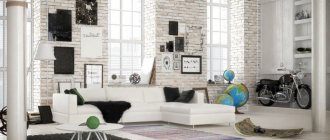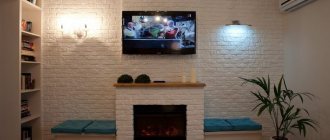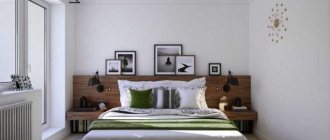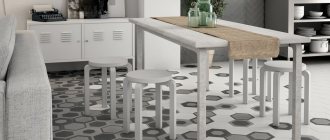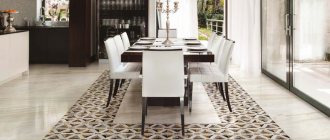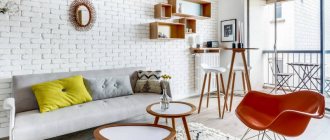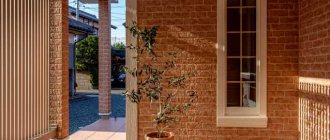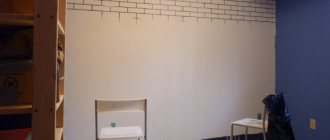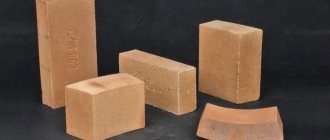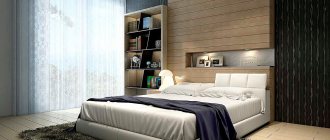Advantages and disadvantages
Artificial panels for the kitchen and natural brick have their pros and cons in interior design.
| Pros of a brick kitchen | Flaws |
| 1. Brickwork is always a bright accent in a room. 2. Natural materials do not require prompt repairs. 3. Brick can be used even in open spaces - in a summer kitchen. 4. You can do the repairs yourself on a modest budget. | 1. The surface of the material must be resistant to moisture and temperature changes. 2. Dirt may accumulate between the bricks, making it difficult to clean. 3. Takes up a lot of space if you use natural masonry or volumetric imitation. |
3D panels in the bedroom interior
The bedroom should be a room in which an atmosphere of peace and tranquility reigns. This can be achieved through carefully planned design ideas. Everything should be thought out to the smallest detail - from the cladding of the room to the decorative items. 3D panels are a way to combine cladding and decoration of the bedroom. Three-dimensional three-dimensional slabs help make any room more interesting.
The main criterion for choosing 3D panels for the bedroom is that the products must be made from environmentally friendly materials. For these purposes, structures made of bamboo, plaster, glass or aluminum are best suited. In some cases, you can find products made of textiles or leather.
The so-called accent wall is typical for the bedroom. It is most often located at the head of the bed. It is the highlight of the room, helping to make the interior exclusive and somewhat unique. Previously, wallpaper of a different shade than on the other three walls was used for this. But now you can transform an accent wall with 3D plaster designs.
Accent wall in the bedroomThe choice of shade for three-dimensional panels should depend on the overall style of the room. However, all experts agree that bright, intense colors are absolutely not suitable for the bedroom. It is better to choose bedding options in dark or light shades. They help you relax and have a positive effect on the nervous system.
Light three-dimensional panel in the bedroom interior
Such panels look especially beautiful at the head of the bed with proper installation of lighting fixtures. Well-placed sconces, floor lamps or chandeliers help recreate the beautiful play of light and shadow, adding a mysterious atmosphere to the room.
How to replace natural material
Decorative brick does not have to be natural. You can make brick-like tiles from porcelain stoneware, PVC, MDF, clinker, gypsum, and plastic. The interior of a kitchen made with imitation material looks no worse than when using natural masonry.
General design rules
The design of a kitchen that features brickwork is based on a number of factors. They should be taken into account before wall decoration begins.
Color solution
The interior design of the room is demanding on the color scheme. In the kitchen it is also important to have a lighted work area. Therefore, when choosing a dark shade for brickwork in this room, it is worth considering whether there will be shades of light in the room and whether there is a sufficient level of illumination.
Light wall
White brickwork in the kitchen apron area or the entire wall, near the dining table, will help make a small room brighter. For covering surfaces in small rooms, it is better to use photo wallpaper and exclusively light shades of brick to visually increase the area of the room.
Dark colors
To repair a wall in dark colors, it is better to use ready-made brick panels: there is always a lot of dirt in the kitchen, and the smooth surface of such material is easy to clean. If the room is large but dark, it is better to focus on 1-2 dark brick elements - for example, in the area for the apron and behind the refrigerator.
Design of facade thermal panels
Ready-made blocks of thermal panels are intended for external decoration of buildings. But sometimes designers use them in interior spaces. Ready-made panels do not weigh down the walls and do not create excess pressure on the foundation.
Structurally, thermal panels have the appearance of a layer cake.
- The top layer is decorative. The layer pattern repeats brick or stone masonry. It also performs the protective functions of the main layer from the actions of nature.
- The main layer serves as thermal insulation. Expanded polystyrene and polyurethane foam are used for its production.
The panels are manufactured at the factory using the latest technology, using special matrices. High-precision connection of panels masks possible installation defects. Cold bridges are never created in the panels. The fastening is reliable and can withstand even the force of slanting rain.
Decorative panels with imitation stone or brick are in demand by consumers due to their decorative qualities. Imitation of natural stone is difficult to distinguish from masonry. And it is easy to care for - just clean it from dust once a year with a damp sponge. The panels have beveled hidden edges that provide a seamless finish. The type of stone finish is resistant to fading in bright sun. There are no scratches on it.
Brick-like thermal panels are popular and considered traditional. They are suitable for many structures and buildings. There are many proposals for choosing the color and texture of bricks. The color of the brick can be white, yellow, gray, red, terracotta. In appearance, aged or burnt, with a rough or smooth surface.
The panels are joined together using the tongue-and-groove method. This ensures the rigidity of the skin, which holds wind loads.
In what design styles is a brick wall suitable for the kitchen?
Brick kitchen decoration is appropriate for many interior styles. The main thing is to take into account the design features and not overload it with an abundance of decor.
Loft
A loft-style kitchen probably simply must include brickwork. It gives naturalness, conciseness and asceticism. Usually natural types of brick or its high-quality imitation of natural shades are used - red, brown, with a rough surface.
Scandinavian
This is a light style, with the addition of simple contrasting elements. Brickwork in a Scandinavian-style kitchen should be a white, cool shade. It can be diluted with wooden decor and furniture.
Country
For country style, decorative bricks are used to decorate the entire wall behind the kitchen furniture or the area above the apron. It is better to use light colors, diluting them with bright ethnic decor and dishes made from natural materials.
Provence
In Provence there is also a place for kitchen bricks. But you shouldn’t highlight large areas and use dark shades. Milky, olive tones and a rough surface with a natural effect will be more appropriate than bright white gloss.
Pop Art
In a house with a kitchen, pop art brick will emphasize creativity and creative impulses. Combinations of different textures, shades, contrast with bright pictures, plastic decor on the set and wooden furniture are appropriate here.
Moisture resistant panel
When the kitchen heats up, you'll be glad you have a moisture-resistant backsplash. Rich browns, deep golds and soft brown tones of realistic-looking tiles provide a sophisticated look while providing added protection against water splashes.
Each box includes 10 apron sections. Before applying, make sure the wall is perfectly clean, grease-free and dry.
How to choose brick tiles
When you don’t have time to lay natural tiles, you can choose imitation. Things to consider:
- Room area, dimensions.
- Room style.
- Features of the climate.
- Your wishes.
- Budget.
A ready-made ceramic brick kitchen apron will cost more than a plastic panel. But a high price is not always an indicator that this kitchen material will be better than a more affordable one.
Builders' opinion
Professional craftsmen and private builders claim that it is not difficult to do the work yourself. Adhesive mixtures are sold ready-made; they are applied with a spatula to the surface. The tiles are glued using a level. Consumers point out the following features during installation work:
- Installation work is carried out at temperatures from +10 degrees and above.
- An adhesive solution for fixing flexible elements should be purchased that is moisture-resistant, for example, TiM No35 or Ceresit CM117.
- To prepare the surface more thoroughly, it is recommended to apply the primer twice, with intermediate drying. A hydrophobic primer or acrylic varnish will do.
- To fix building units on corners and complex architectural elements, the product is heated with a construction hairdryer.
Types of bricks
Brick in kitchen design can be different. Natural coverage works best, but it is not always appropriate. It is not necessary to buy natural material if there is no money or space does not allow. It can be replaced with an imitation, and done with your own hands.
Natural brick
A brick summer kitchen should be made primarily from natural materials. For example, natural masonry. It is massive, durable and is not afraid of temperature changes and humidity. But the cost of natural bricks, especially unusual shades, is higher than artificial materials.
Facing brick
It is made from several materials: clinker, ceramics, gypsum, porcelain stoneware. Outwardly it is very similar to natural, but inferior to it in strength. Easy to install.
Stages of attaching flexible bricks to the facade
Before you begin facing work, you will need to perform basic cleaning of the base coating from particles that are peeling off. Next, the surface is inspected, and if cracks or chips are found, they should be repaired. If there is unevenness in the plane, leveling is performed with cement compounds.
Work progress:
- The working area is treated with a special deep penetration primer. This technique will ensure good adhesion. If fungus or mold is found in the work area, additional cleaning and treatment with an antiseptic solution will be required.
- Laying begins from the bottom, then gradually moving towards the top of the wall.
- An adhesive solution is applied to an area of one square meter using a construction spatula.
- The applied mixture is leveled with a notched spatula. It is recommended to use a tool with a tooth size of 3 millimeters.
- The facing fragment is applied to the fastening site and rolled on top with a rubber roller.
- The next unit is placed taking into account the required seam width. To do this, use mounting crosses.
- To correct unevenly attached elements, use a rubber mallet.
- To imitate brickwork, each next row is laid with an offset of half a brick.
- If the adhesive mixture lies unevenly in the seams, it can be corrected with a brush.
After finishing the work, it will take time to dry the adhesive mass. Then the facing surface is treated with hydrophobic varnish. This product will facilitate cleaning work and create a protective layer.
Brickwork in kitchen design
For the kitchen, brick is a fairly popular material. Natural is suitable for the apron area, and lightweight plastic, panels or gypsum are suitable for wall cladding. When choosing, you should consider the style of the room’s design and its dimensions.
Loft
Brick tiles for a loft kitchen are always a suitable solution. You can cover a large space with it, including several walls and an apron area, and experiment with shades.
Country
Another style in the spirit of romanticism and rustic motifs, in which brickwork can be done exclusively in natural shades. Unlike romanticism, dark brick may be appropriate here, but only in natural tones. It is better to choose open areas: an apron, a wall, including a natural structure, which can be simply treated and left unchanged.
Provence
A kitchen in the Provence style is characterized by the use of romantic, “rustic” decor. Brick will fit into such an interior if it is light in color and has a glossy texture. It can be set off with decor made of wood (table, set), furniture made of soft fabrics (sofa, chairs), paintings with light frames. Colors for masonry - white, milky, blue, beige, lilac.
Minimalism
Does not provide a lot of decor and an abundance of bright colors. Therefore, brickwork can become the only bright accent in the kitchen. You can highlight an apron or an entire wall. The main thing is not to load the surface with other details and adhere to the unity of textures.
Antique style
Combines different textures from natural wood, stone, metal. Therefore, it is better to choose large surfaces for brick in the kitchen and natural shades - brown, red, burgundy.
English style
The conservative English style does not accept aggressive decisions. Therefore, the color of the brick in the kitchen should be light, and the masonry itself should be small and harmonious, for example, in the apron area.
Brick apron
Update your kitchen with a rustic decor with an attractive stone look backsplash at a very affordable price. Available in roll sizes, the stone is easy to install to provide a high-quality image of actual stacked stones.
Simply clean the wall surface well, remove the vinyl backing, and carefully position the backsplash, using a sharp utility knife to cut all the holes. Your rustic or cottage style kitchen will be beautifully updated and the wall will receive additional splash protection.
Color palette
Brickwork in the kitchen is distinguished by a variety of colors. Each shade is appropriate in a specific style and is selected in accordance with a specific room and interior design.
White brick in the kitchen interior
White brick is common in the kitchen. It visually makes the space lighter, the room wider, more spacious. You can lay the entire wall or just the apron area - it all depends on the size of the room and the choice of material.
Red brick
Red brick masonry in a kitchen is usually placed above the countertop. If the house is brick, you can leave one small wall, cleaning it and covering it with protective varnish.
Gray brick
Design solutions with gray brick are often embodied in loft kitchens. Other colors used for interior decoration when choosing cladding of this shade: white, black, dark brown, silver.
Black brick
Wall cladding with black brick is appropriate only in moderation - in the apron area, behind the kitchen unit, behind the TV, refrigerator and other appliances. This option is only suitable for a room with natural light and large windows: the black color and rough surface of the brickwork will “take away” the light. Therefore, darkened kitchens with black brickwork will be quite gloomy.
Aged brick
A kitchen-living room with natural aged brick in a classic, modern or loft style will look most advantageous. This option is appropriate when the house/apartment has a finished brick wall, for example, the load-bearing structure of a building. Repair costs here will be minimal, and the surface itself will become one of the main accents of the interior.
Installation of flexible stone
One of the advantages of this facade covering is considered to be trouble-free installation - the tiles are fixed with a special adhesive mixture, which is usually included in the line of each brand.
Preparation
The base must be level. If you plan to refresh a brick facade that has lost its appearance in this way, you will have to first level it with a thin layer of plaster. Smooth block or slab walls do not require additional finishing, except for cleaning from dust and preliminary priming with a deep penetration compound.
When laying on a layer of insulation, it, according to the selected technology, must be protected by a reinforcing layer on which the tiles are already mounted. If you plan to imitate brickwork, the decorative effect will largely depend on the seams, so first mark for a 10-12 mm seam. When the cladding imitates stone, marking is not required, since even seams will not work anyway, and broken seams will hide any errors.
Laying
The tiles are laid on a uniform layer of adhesive previously applied with a notched trowel (tooth 3 mm); if necessary, the material is cut with a construction knife from the back. After preliminary fixation in place, the segments are rolled with a pressure roller for final fixation. Additional filling of the seams is not required; the compound released during rolling reliably seals the tile around the entire perimeter; before hardening, it is recommended to smooth the seams with a brush to smooth out the relief.
If additional elements are not used, you can use a hair dryer to simplify fixation in the corners. Depending on the manufacturer, flexible cladding is produced either completely finished or requiring the application of a protective coating (silicone or acrylic primer) after installation. For some brands, each segment is immediately covered with a protective layer to prevent glue from getting onto the surface (tiles with marble chips). After installation, the protection is simply removed, and no further adjustment is required.
Great examples and ideas for a brick kitchen
Ideas for using bricks in the kitchen:
- Apron.
- Dinner Zone.
- The area near the window opening.
- The area behind the kitchen unit.
- One wall.
- All walls in the room.
- False wall.
- Area behind appliances (TV, refrigerator, microwave oven).
Brick has been used in the kitchen for a long time. To make it last longer, the finished surface should be treated with a protective layer from moisture and dust.
Read
